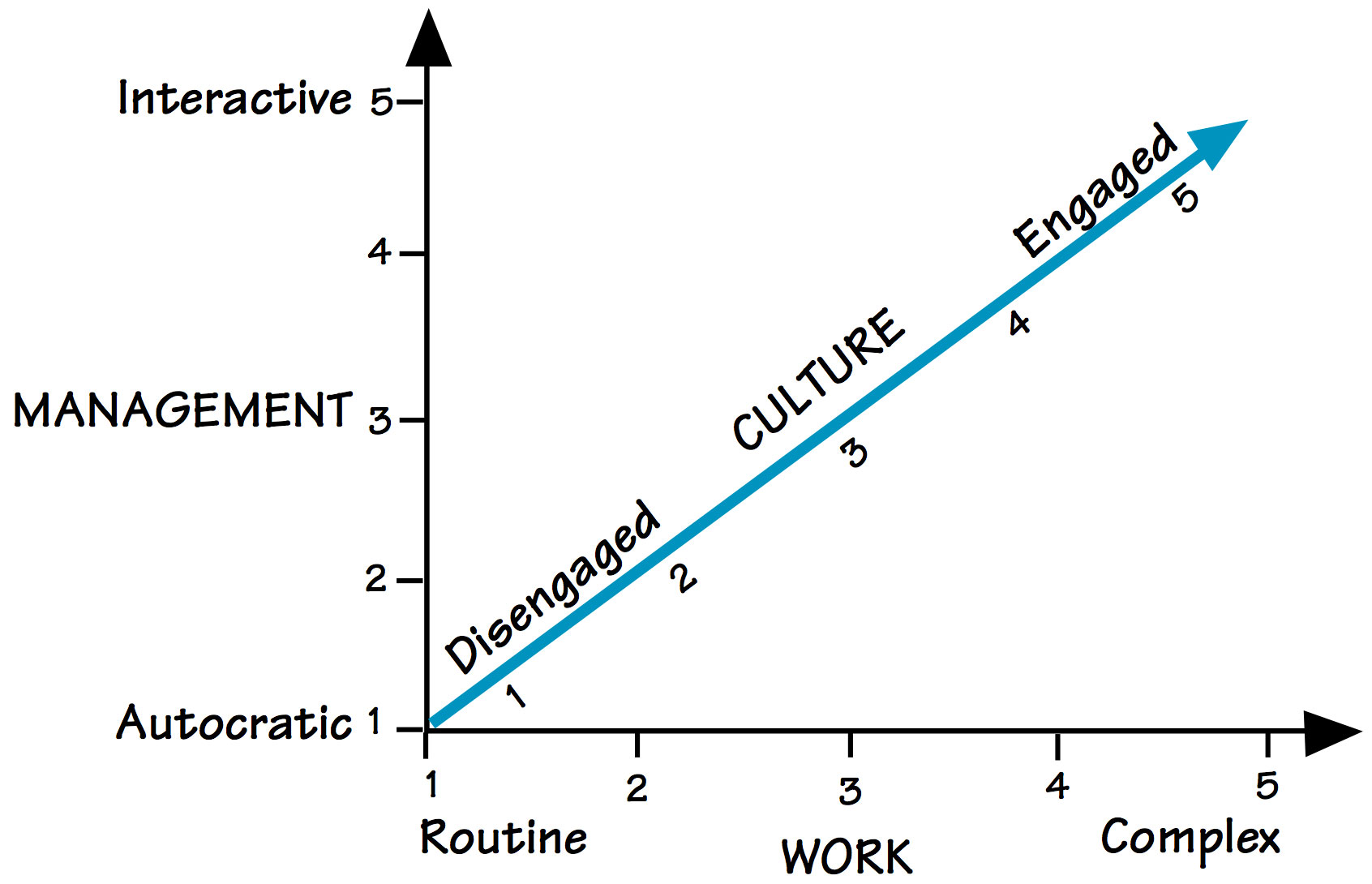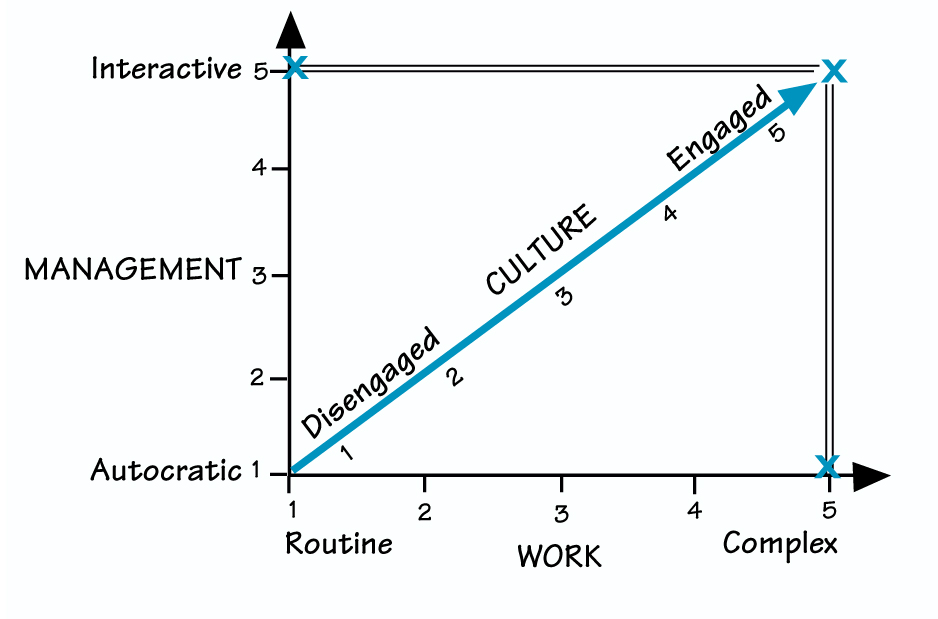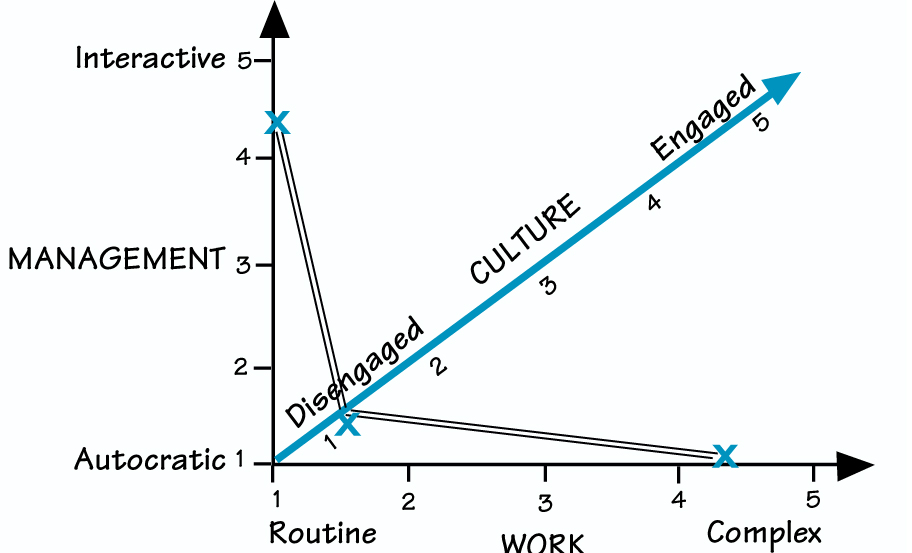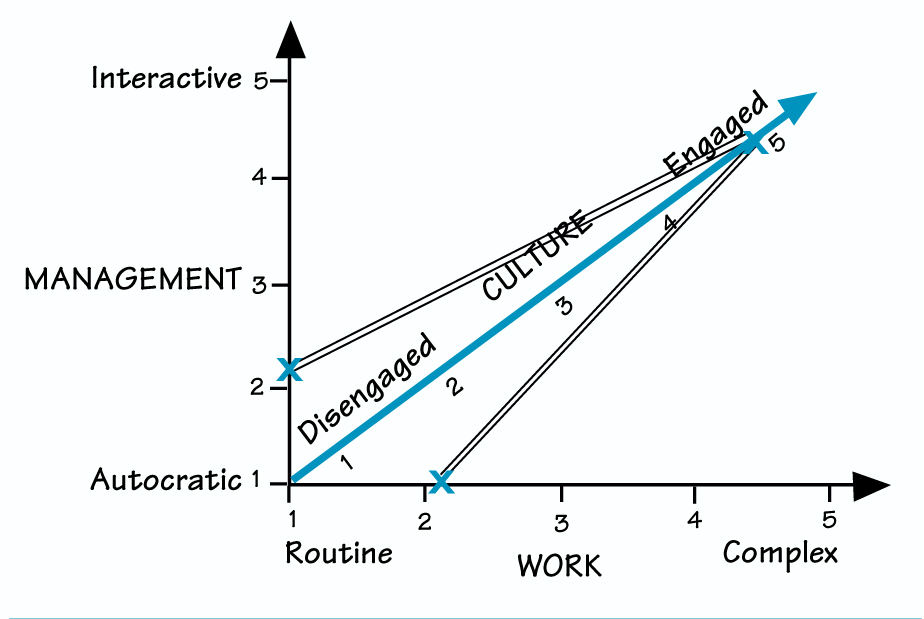In this information-rich and knowledge-based economy, new models, methods, and tools proliferate more rapidly than spam in our email inboxes. Yet there is one simple and time-honored tool I consistently use with my own group or with clients— the “Back of a Napkin” model, more formally referred to as the “Systems Equilibrium” model. It is a straightforward mapping tool that helps consultants or managers guide change or assess the equilibrium of an organization’s systems.
By answering a couple of questions and connecting a few lines on the back of a napkin or piece of scrap paper, you gain insight about the level of “fit” among three critical and interdependent components:
- Work system
- Cultural system
- Management system
When these systems are aligned, the organization is better able to achieve its goals. And isn’t that what it’s all about?
SYSTEMS EQUILIBRIUM MODEL

The Work System. First, draw a horizontal line and number it from one to five (see “Systems Equilibrium Model”). Label it the “Work System.” This line symbolizes the actual tasks or technology performed by a specific group. At the left end of the continuum is “Routine” work—simple activities such as stacking widgets on an assembly line, flipping burgers, or processing paperwork in the same repetitive way. Because it is easy to master, routine work does not require employees to have intensive training or to exercise independent thought.
The other end of the continuum represents “Complex’’ tasks, defined as challenging, ambiguous, or complicated projects. Complex work requires a high degree of expertise, decision-making, and analysis. Salespeople out in the field and highly skilled knowledge workers are all engaged in complex work. Rate your group’s work system below by placing an “X” at the appropriate number.
The Management System. The second component in this model is the “Management System,” which represents forms of decision-making, levels of organizational structure, and leadership styles. Draw a line that is perpendicular to the first one, and number it from one to five, from the bottom up. Label number one “Autocratic” and number five “Interactive.” In “autocratic” systems, positional power, command-and-control bosses, centralized decision-making, and an emphasis on face-time in the office are the norm.
At the other end of the continuum, “Interactive” represents mangers who return authority to others, rely on personal power, and engage in coaching and collaboration to achieve results through empowered people, processes, and systems. Because decisions are typically participatory and decentralized, employees are frequently trusted to work from home or out in the field with customers. Place an “X” on the number that best describes your management system.
The Cultural System. Organizational culture is a complex web of symbols, stories, heroes, attitudes, dress codes, tacit behavioral patterns, and physical spaces. It powerfully affects motivational levels, empowerment, and the amount of energy people choose to exert. Whenever we try to enact a change in business, culture can be the biggest obstacle.
Draw a diagonal line midway between the “Work System” and “Management System” lines, and number it one to five. Label this continuum “Disengaged” at number one and “Engaged” at number five. People in a disengaged culture are less emotionally invested than in an engaged one. Disengaged cultures don’t easily adapt to change and can be characterized by finger pointing or blaming of others. Employees often feel isolated or forgotten, which can create an “us against them” mindset.
At the other extreme, engaged cultures are resilient and accountable. People have a can-do, team-oriented attitude, which empowers them to be creative and solutions oriented. Rate your cultural system by placing an “X” at the appropriate number below.
Diagnosing Systems Equilibrium
At this point, you simply connect the three lines as illustrated in “Sample Model” to assess the level of systems alignment. Optimally, you would find congruency and fit among the three systems, indicated by a right angle when the “Xs” are connected. In this case, the three systems reinforce and support each other.
SAMPLE MODEL

A right angle square indicates equilibrium.
For example, the Work system for knowledge workers would typically be defined as ‘Complex.” The optimal Cultural system to support complex work would be “Engaged,” because the tasks require a customer-oriented, accountable and empowered workforce. Finally, “Complex” projects are most successful with the support and flexibility found in an “Interactive” Management system, because knowledge workers often know more about the actual work than do their managers.
Key Points
The premise of this model is that an organization should strive toward congruency in the three systems to create a reinforcing, supportive state of equilibrium. If you have achieved that goal, the next step is to engage workers more fully in the organization’s mission by increasing the size of your “square.” So, if you rated all your systems a two, the square that results when you connect the “Xs” will be smaller than if you rated them a five. What should you do if your square is relatively small?
The best place to start is with the Work system. All systems should revolve around and support the work—the core of what the group does to add value. Find ways to gradually increase task complexity through job enrichment and by redefining some tasks so they aren’t unnecessarily repetitive. However, if micromanage- ment and disempowerment have been the norm, don’t expect many employees to embrace the change—you may need to hire new people to take the organization to the next level.
Diagnosing Systems Disequilibrium
When the three systems do not align, the system is in disequilibrium. There are two common states of disequilibrium. The first is called the “Bow and Arrow Effect,” which occurs when the Cultural system pulls negatively in on the Management and Work systems (see “Bow and Arrow Effect”). This dynamic typically occurs when managers suddenly demand that employees process work or interact differently. It can also be a result of a layoff, reorganization, or other significant organizational change.
BOW AND ARROW EFFECT

To respond to the Bow and Arrow Effect, managers must use empathy and inspiration to engage everyone in the process. Over time, and with sustained persistence, the organization will gradually move toward equilibrium if managers effectively implement longterm change efforts and congruent systems to support the desired behaviors.
Another common state of disequilibrium is the “Rubber Band Effect,” which occurs when the Cultural system evolves beyond the other two systems (see “Rubber Band Effect”); that is, when management introduces new norms and practices without changing the nature of work or management style. After a while, without changes in the other systems, the Cultural system will revert to the status quo.
RUBBER BAND EFFECT

If you are attempting to think of ways to gradually shift the other two systems as well. Start first with the Work system by enriching people’s job. Then, introduce participatory management practices, which may include reorganizing and flattening the organizational structure.
The Systems Equilibrium model is both diagnostic and prescriptive. By simply drawing a meaningful snapshot of current systems, you can diagnose disparities among them. Once you see the source of the disequilibrium, you can prescribe specific interventions and move closer to equilibrium. By bringing these three systems into equilibrium, workers will be more satisfied, and the organization will better be able to achieve its goals.
Janet Macaluso (janet@learning2lead.net) is a consultant member of the Society of Organizational Learning who specializes in creating competitive organizational value through leadership and teams. She is the founder of Learning2LEAD. This article is an adaptation of the earlier “Inter-Systems Approach” developed more than 30 years ago by one of Janet’s most memorable teachers, the late Patrick Williams of Pepperdine University.
